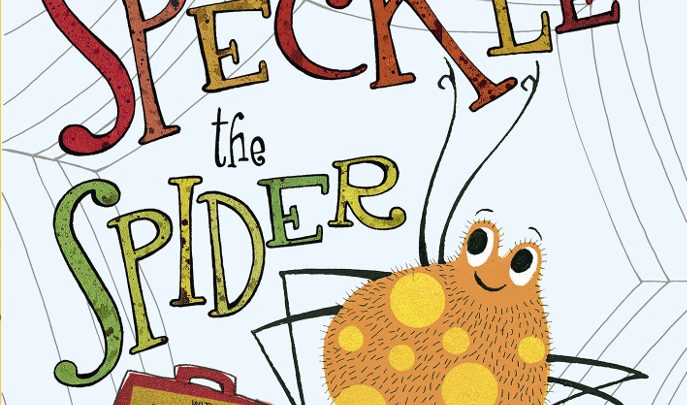KS1 Book Topic – Inspire Reading and Writing With Speckle the Spider

A talent for tap dancing and an adventurous spirit – introduce your KS1 pupils to Speckle, a very special spider indeed…

- by Judy Clark

With the new curriculum I love that there’s a lot less prescription when it comes to genre, that there’s an emphasis on depth in exploring the writing process, and that talk and response is to be found at the heart of reading enjoyment and comprehension.
Opportunities to immerse pupils in engaging, cross-curricular English abound; the programme of study gives us the freedom to take a book like Speckle the Spider and inspire a whirlwind of writing for purpose.
A life less ordinary
Emma Dodson’s eccentric book, packed with flaps and inserts to explore, follows the fortunes of a rather unappreciated spider, Speckle. Desperate for fame, fortune and to thrill the world with his astounding razzle-dazzle dancing, he sets out on a journey of discovery.
Inspired by his friend Mr Flip Flap, the flea who is travelling the world with a flying circus to great acclaim, he leaves his home in the Bahamas (by banana boat, of course) on a quest to show the world how special he is. Obviously his brave optimism doesn’t quite go to plan…
Sometimes, the devil is in the detail and if you encourage pupils to scrutinise Speckle’s facial expressions throughout the book they will find a spider with self-belief in spades. He is forever smiling despite adversity. It’s a great idea, therefore, to start a whole class ‘role on the wall’ (in spider form, of course) for pupils to make notes and comments about Speckle’s personality as you move through the story.
1. A very special spider
We meet Speckle at Sunnyside School for Spiders where he is forever in trouble for ‘poor spider skills’, too much dancing and not enough silk spinning. Pupils can read his actual school report written by his teacher, Miss Tina Tarantula. However, despite a lack of appreciation, Speckle has a sneaking suspicion that he is a very special sort of spider.
Talents galore – SMSC opportunities Explore and discuss with the class what it is to be special. Do they think it is about having particular talents, like Speckle, or other personal qualities? Do the children think they are special and unique? Perhaps they could design and write school reports for each other (hopefully not like Miss Tarantula’s), recognising the talents, abilities and personal qualities of their peers.
Organise a class talent show and discover your class’s hidden talents. Writing invites to parents, designing posters and adverts to promote the show, or even filming a short, X Factor-style trailer will inspire pupils to write for purpose and audience.
Speckle receives a letter from his friend, Mr Flip Flap, about his exciting life in the World Famous Flying Flea Circus, complete with a promotional flyer. Use the flyer with its alliteration, word play, rhymes and great design to model a promo for your show. (Dangerous Doris the Dung Beetle is probably my favourite act – or could it be Weevil Knievel…)
Another great book to support this theme is You are Special, by Max Lucado – a lovely story about what it is to be unique and how easily the opinions of others can erode self belief.
An abundance of alliteration Sunnyside School, Tina Tarantula, Freddy the Freakshow Flea, the Big Banana Boat – this story is jammed-packed with alliteration. As you begin the book, start a class comment board to collect all the examples children come across as they read (there are lots).
Consider the effect alliteration has on us as readers. Does it give us a clue to a character’s personality (eg Freddy Fearless) or perhaps make a headline eye catching (eg Rare Spider Spotted in Surbiton)?
It is great for pupils to be able to spot techniques, but essential they understand why, as writers, they might bother to use them. The effect on the reader is, of course, always key – a great message for young writers.
2. Into the big blue yonder
Speckle, now enthused by thoughts of fame and travel, teams up with a bunch of bananas to leave the Bahamas and set sail for adventure, complete with his very own lift-the-flap ticket – bearing a number of restrictions.
Where in the world Why not create your own class travel agents? This would make a fantastic role-play environment where pupils could research the location of the Bahamas and display a world map showing Speckle’s home.
Once again there are great opportunities to write for purpose. Pupils could design and create their own passports, make their own tickets, and think up their own innovative restrictions – how about plane tickets with ‘no snakes allowed’ or hovercraft trips where hedgehogs are banned from travel?
Perhaps the class could put together and then display a travel brochure advertising the Bahamas as the ideal trip of a lifetime? Or they could write persuasive leaflets for their own holiday locations.
Back to earth with a bump Our intrepid spider lands somewhere that looks rather like a house near you or me. The reaction he gets is not quite what he is expecting and after a few traumatic experiences (and a fair bit of dancing) he thinks he has finally found his escape down a plug hole. But no, here’s where his adventures really begins.
Perfect prediction Prediction skills are fundamental in developing comprehension and Emma Dodson provides many opportunities to put this into practice. First we can encourage pupils to think about what reaction Speckle might receive if he landed on a bunch of bananas in their own kitchen, especially if he starts to tap dance.
We also see the world through Speckle’s eyes: he encounters a big, furry giant, then is chased by an enormous pink monster – finally seeking refuge in a big, white hiding place. What on earth might he be seeing in his new habitat?
3. Fame at last!
Having been captured by the big, pink monsters, Speckle gets sent by post to Professor Knowitall.
Due to his extreme rarity, he ends up not only in the local zoo, but hits the headlines and finds himself the centre of a media frenzy. The result is a pile of fan mail and a constant stream of admirers he can finally impress with his dancing skills.
There is only one other spider like Speckle known to exist, and she just happens to live in the same country. ‘Stunner’ Suzy (yep, that’s another one for the comment board) is famed for her somersaults and the two become a celebrity couple.
Fascinating facts The book contains a feast of inspiration for young writers in the form of various models: spider supplements, newspaper articles, spider facts, etc.
Pupils could create their own ‘fascinating fact files’, choosing a spider species to research, or they might seek out the most unusual facts about spiders to include in a class trivia quiz and test their friends. Did you know the smallest spider in the world is so tiny that you could fit 10 of them on the end of a pencil? This is just one of the facts found at the end of this fabulous book.
Alternatively, using the spider supplement as a guide, you could innovate and use its headings as a model to apply to facts about another dangerous minibeast. For example:
• Scared of scorpions? • Scorpions are very clever. • Where do scorpions live? • Are all scorpions poisonous?
Budding journalists
With three great examples of newspaper front pages and articles, the chance to explore the world of journalistic writing can’t be missed. Children can experience the fun of headline writing – using all that alliteration to good effect – decide how to layout the front page of their paper, and invent titles (The Daily Snail and The Bun are two examples from the book).
Eventually, Suzy and Speckle do get a little disillusioned and decide to head home, creating yet more headlines (‘Superstar spider couple at large’), but budding journalists may want to document the pair’s triumphant return home to the Bahamas, complete with exclusive interviews about their experiences.
Close observation poetry on a spider image, formal letters to professor Knowitall, writing their own fan mail to Suzy and Speckle… the writing could go on and on. What is, in many ways, a more open curriculum, coupled with an engaging and inventive book, makes for tantalising teaching and limitless learning. (Sorry, I couldn’t resist!)
Following the thread
Three books to support your spider topic…
1. Aaarrgghh! Spider, by Lydia Monks This hilarious book is about a spider with a similar problem to Speckle – though she doesn’t want to dance, she wants to be the family pet. Her ‘owners’, however, don’t have quite the same idea of what a family pet might be.
2. Spider Watching, by Vivian French Part of the Read and Wonder series, Spider Watching is packed with interest for those becoming obsessed by the world of the spider.
3. The Spider and The Fly, by Tony Di Terlizzi The classic cautionary verse is brought to life by the acclaimed artist Di Terlizzi, who is inspired by his love of classic Hollywood horror movies. It’s a visual feast with a sting in its tail. Judy Clark is primary adviser at the National Literacy Trust. She is also English ITE lecturer, and Talk4writing Adviser, together with Pie Corbett.











